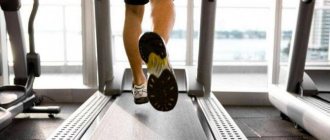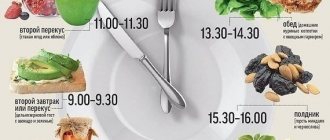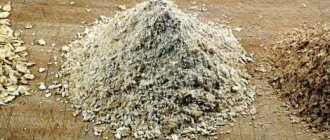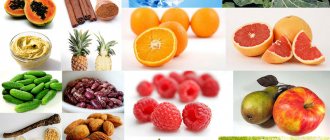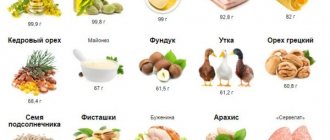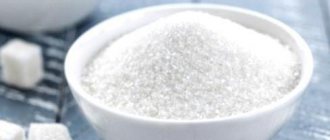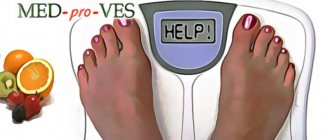Sports achievements depend on a number of factors: building cycles in the training process, recovery and rest, nutrition, and so on. If we consider the last point in detail, glycogen deserves special attention. Every athlete should know about its effect on the body and training productivity. Does the topic seem difficult? Let's figure it out together!
Sources of energy for the human body are protein, carbohydrates and fats. When it comes to carbohydrates, this raises concerns, especially among those losing weight and athletes who are cutting. This is due to the fact that excessive consumption of macronutrients leads to excess weight gain. But is it really that bad?
In this article we will look at:
- what is glycogen and its effect on the body and training;
- places of accumulation and methods of replenishment of stocks;
- the effect of glycogen on muscle gain and fat burning.
What is glycogen
Glycogen is a type of complex carbohydrate, a polysaccharide, containing several glucose molecules. Roughly speaking, this is neutralized sugar in its pure form, which does not enter the bloodstream until the need arises. The process works both ways:
- after eating, glucose enters the blood, and the excess is stored in the form of glycogen;
- During physical activity, glucose levels drop, the body begins to break down glycogen with the help of enzymes, returning glucose levels to normal.
The polysaccharide is confused with the hormone glucogen, which is produced in the pancreas and, together with insulin, maintains the concentration of glucose in the blood.
How is it formed
Glycogen synthesis refers to the creation and storage of new glycogen granules. Initially, proteins, fats and carbohydrates from our food are broken down into smaller molecules. Proteins are broken down into amino acids, fats into triglycerides, and carbohydrates into a simple sugar called glucose. Our body is capable of converting proteins and fats into glucose, but this process is very inefficient. And as a result, its quantity is only sufficient to maintain the basic functions of the body. This only happens when glycogen levels become very low. Therefore, to obtain a significant amount of glucose, it is most effective to consume carbohydrates.
Only about 4 grams (one teaspoon) of blood glucose can circulate in the body at any given time, and if levels rise much higher than this, damage to nerves, blood vessels and other tissues occurs. There are several mechanisms to prevent glucose from entering the bloodstream.
The main way the body gets rid of excess glucose is by packaging it into glycogen granules, which can then be stored safely in muscle and liver cells.
When the body needs extra energy, it can convert these granules back into glucose and use it as fuel.
Biochemical properties
The substance was discovered by the French physiologist Bernard 160 years ago while studying liver cells, where “spare” carbohydrates were found.
“Spare” carbohydrates are concentrated in the cytoplasm of cells, and during a lack of glucose, glycogen is released and subsequently enters the blood. Transformation into glucose to meet the body's needs occurs only with the polysaccharide, which is located in the liver (hypatocide). In an adult, the reserve is 100-120 g - 5% of the total mass. The peak concentration of hypatocide occurs an hour and a half after ingesting carbohydrate-rich foods (flour products, desserts, foods high in starch).
The polysaccharide in muscles occupies no more than 1-2% of the tissue mass. Muscles occupy a large area in the human body, so glycogen reserves are higher than in the liver. Small amounts of carbohydrate are present in the kidneys, brain glial cells, and white blood cells (leukocytes). The glycogen concentration in an adult is 500 grams.
Interesting fact: “spare” saccharide is found in yeast, some plants and bacteria.
Where is it contained and what are the functions?
Where glycogen is stored for later use:
In the liver
Inclusions of glycogen in liver cells
The main stores of glycogen are in the liver and muscles. The amount of glycogen in the liver can reach 150 - 200 g in an adult . Liver cells are the leaders in the accumulation of glycogen: they can of 8% of this substance.
The main function of liver glycogen is to maintain blood sugar levels at a constant, healthy level .
The liver itself is one of the most important organs of the body (if it is even worth holding a “hit parade” among the organs that we all need), and the storage and use of glycogen makes its functions even more responsible: high-quality functioning of the brain is possible only thanks to normal sugar levels in the body .
If the blood sugar level decreases, then an energy deficiency occurs, due to which the body begins to malfunction. Lack of nutrition for the brain affects the central nervous system, which becomes depleted. This is where glycogen breakdown occurs. Then glucose enters the blood, thanks to which the body receives the necessary amount of energy.
Let us also remember that in the liver not only the synthesis of glycogen from glucose occurs, but also the reverse process - the hydrolysis of glycogen to glucose. This process is caused by a decrease in blood sugar concentration as a result of the absorption of glucose by various tissues and organs.
In the muscles
Glycogen is also deposited in muscles. The total amount of glycogen in the body is 300 - 400 grams. As we know, about 100-120 grams of the substance accumulates in liver cells, but the rest ( 200-280 grams ) is stored in the muscles and makes up a maximum of 1 - 2% of the total mass of these tissues.
Although, to be as precise as possible, it should be noted that glycogen is not stored in muscle fibers, but in sarcoplasm - the nutrient fluid surrounding the muscles.
The amount of glycogen in muscles increases in the case of abundant nutrition and decreases during fasting, and decreases only during physical activity - prolonged and/or intense.
When muscles work under the influence of a special enzyme phosphorylase, which is activated at the beginning of muscle contraction, increased breakdown of glycogen in the muscles occurs, which is used to provide glucose for the work of the muscles themselves (muscle contractions). Thus, muscles use glycogen only for their own needs.
Intense muscular activity slows down the absorption of carbohydrates, while light and short work enhances the absorption of glucose.
Liver and muscle glycogen are used for different needs, but to say that one of them is more important is absolute nonsense and only demonstrates your wild illiteracy.
Everything that is written on this screen is complete heresy. If you are afraid of fruits and think that they are directly stored in fat, then do not tell this nonsense to anyone and urgently read the article Fructose: is it possible to eat fruits and lose weight?
Functions of glycogen
Two sources of energy reserves play their role in the life of the body.
Liver reserves
The substance, which is located in the liver, supplies the body with the required amount of glucose, responsible for the constancy of blood sugar levels. Increased activity between meals reduces plasma glucose and glycogen from liver cells is broken down into the bloodstream and equalizes glucose levels.
But the main function of the liver is not the conversion of glucose into energy reserves, but the protection of the body and filtration. In fact, the liver reacts negatively to surges in blood sugar, exercise, and saturated fatty acids. These factors lead to cell destruction, but later regeneration occurs. Abuse of sweet and fatty foods in combination with systematic intense training increases the risk of metabolic disorders of the liver and pancreas.
The body is able to adapt to new conditions, making an attempt to reduce energy costs. The liver processes no more than 100 g of glucose at a time, and the systematic intake of sugar in excess of the norm forces the restored cells to convert it directly into fatty acids, ignoring the glycogen stage - this is the so-called “fatty degeneration of the liver,” leading to hepatitis in the case of complete degeneration.
Partial degeneration is considered normal for weightlifters: the role of the liver in the synthesis of glycogen changes, slowing down metabolism, and the amount of adipose tissue increases.
What is it in biology: biological role
Our body needs food first of all as a source of energy, and only then as a source of pleasure, an anti-stress shield or an opportunity to “pamper” itself. As you know, we get energy from macronutrients: fats , proteins and carbohydrates .
Fats provide 9 kcal, and proteins and carbohydrates provide 4 kcal. But despite the high energy value of fats and the important role of essential amino acids from proteins, carbohydrates are the most important “suppliers” of energy to our body.
Why? The answer is simple: fats and proteins are a “slow” form of energy, because... their fermentation requires a certain time, and carbohydrates are relatively “fast” . All carbohydrates (be it candy or bran bread) are eventually broken down into glucose , which is necessary to nourish all cells of the body.
Carbohydrate breakdown scheme
Structure
Glycogen is a kind of “preservative” of carbohydrates, in other words, the body’s energy reserves - glucose stored in reserve for subsequent energy needs. It is stored in a water-bound state. Those. glycogen is a “syrup” with a calorie content of 1-1.3 kcal/g (with a calorie content of carbohydrates of 4 kcal/g).
In fact, the glycogen molecule consists of glucose residues; it is a reserve substance in case of lack of energy in the body!
The structural formula for the structure of a fragment of the glycogen macromolecule (C6H10O5) looks schematically like this:
What type of carbohydrates is it?
In general, glycogen is a polysaccharide, which means it belongs to the class of “complex” carbohydrates:
What products contain
Only carbohydrate can go into glycogen. Therefore, it is extremely important to keep the carbohydrate level in your diet at least 50% of the total calories. By consuming a normal level of carbohydrates (about 60% of the daily diet), you preserve your own glycogen to the maximum and force the body to oxidize carbohydrates very well.
It is important to have baked goods, cereals, cereals, various fruits and vegetables in your diet.
The best sources of glycogen are: sugar, honey, chocolate , marmalade, jam, dates, raisins, figs, bananas , watermelon, persimmon, sweet pastries.
Persons with liver dysfunction and enzyme deficiency should be wary of such foods.
Bodymaster.ru recommends Fitness Trainers:
In muscle tissue
Reserves in muscle tissue support the functioning of the musculoskeletal system. Do not forget that the heart is also a muscle with a glycogen reserve. This explains the development of cardiovascular diseases in people with anorexia and after prolonged fasting.
This begs the question: “Why does consuming carbohydrates lead to extra pounds when excess glucose is stored as glycogen?” The answer is simple: glycogen also has reserve boundaries. If the level of physical activity is low, then energy does not have time to be used up, and glucose accumulates in the form of subcutaneous fat.
Another function of glycogen is the catabolism of complex carbohydrates and participation in metabolic processes.
Basics of Glycogen Metabolism
Translator: Tatyana Arkharova
Editor: Veronica Rees
Source: NCBI
During intense exercise and prolonged physical activity, muscle glycogen is broken down, releasing glucose molecules. These molecules are then oxidized by muscle cells through anaerobic and aerobic processes to form the adenosine triphosphate (ATP) molecules needed for muscle contraction. The rate at which muscle glycogen is destroyed depends primarily on the intensity of physical activity.
The recommended daily intake of carbohydrates for sedentary adult men and women is about 130 g. This value depends on the duration and intensity of exercise. For example, on days with little physical activity, muscle tissue requires significantly less carbohydrates to restore muscle and glycogen than on heavier training days. For this reason, current recommendations for carbohydrate intake in athletes vary depending on daily exercise. However, athletes often do not consume enough carbohydrates.
Glycogen is stored in the cytosol of cells, occupying 2% of the volume of heart cells, 1-2% of the volume of skeletal muscle cells and 5-6% of the volume of liver cells. Neither short-term fasting nor prolonged sitting affects muscle glycogen stores, although cardiac muscle glycogen may increase during fasting as amino acids and glycerol are converted to glucose and stored as glycogen to provide the heart with sufficient energy reserves.
To prepare the body for subsequent training and competition, it is important that glycogen stores in the muscles and liver are replenished. This article summarizes nutrition, training, and recovery recommendations for athletes and people involved in regular physical activity. During intense exercise, blood glucose and muscle glycogen are the primary fuels that are oxidized to produce ATP.
In addition to human muscle and liver cells, glycogen accumulates in small quantities in brain cells, heart cells, smooth muscle cells, kidney cells, red and white blood cells, and even fat cells. Under normal conditions, glucose is the only fuel the brain uses to produce ATP; At rest, approximately 60% of blood glucose is metabolized by the brain.
Because the brain requires glucose, it is critical to maintain euglycemia (normal blood glucose levels) during rest and exercise. To ensure there is an adequate supply of glucose in the brain, the liver releases glucose into the bloodstream.
The use of muscle glycogen during exercise reduces the absorption of glucose from the blood, thereby helping to maintain blood glucose levels in the absence of carbohydrate intake. Adequate carbohydrate intake during exercise helps maintain liver glycogen stores and has been reported to spare glycogen in type II (fast twitch) muscle cells.
In the 1920s, it became apparent that carbohydrates were important for muscle training, that blood glucose concentrations were associated with fatigue, and that increasing carbohydrate intake before competition, as well as eating candy during it, prevented weakness and fatigue. Despite these observations and the much earlier discovery of glycogen in 1858, the relationship between dietary carbohydrate, muscle glycogen, and exercise performance was not confirmed until the 1960s.
The glycogen content of the entire body is approximately 600 g, and this figure varies depending on body weight, diet, fitness and exercise. During intense and long-term exercise, the glycogen content in muscle cells can be significantly lower, but does not fall less than 10% of the initial data.
The role of glycogen
Muscle glycogen is not only a source of energy, but also a regulator of signaling pathways involved in training adaptation and influencing intracellular osmolality. Measuring muscle glycogen stores is possible using muscle biopsy techniques.
Factors affecting glycogen stores
Glycogen stores in the liver and muscles decrease with physical activity: the longer and more intense the activity, the greater the rate and overall decrease in glycogen stores. A diet rich in carbohydrates leads to a gradual overcompensation of muscle glycogen stores.
Figure 1. Glycogen metabolism at rest and during exercise.
The reduction in muscle glycogen stores that occurs during exercise is a major driving factor for subsequent glycogenesis. After exercise, muscle glycogen recovery occurs in two stages.
At the first stage, glycogen synthesis is rapid - 12-30 mmol/g mass/hour; insulin is not required and lasts 30-40 minutes if glycogen depletion is significant. The second phase is insulin dependent and proceeds more slowly with euglycemia - 2-3 mmol/g body weight/hour - the rate of which can be increased with additional carbohydrate intake.
During many exercises, the release of insulin is blunted and adrenaline is released by the adrenal glands. The rate of glycogen degradation (glycogenolysis) depends on the intensity of exercise.
Glycogen concentration measurement
In trained and well-fed athletes, the muscle glycogen concentration is approximately 150 mmol/kg body weight after at least 8-12 hours of rest. It can reach levels of 200 mmol/kg body weight in well-trained, rested athletes after several days on high-carbohydrate diets, and after prolonged intense exercise, muscle glycogen can fall to <50 mmol/kg body weight.
When muscle glycogen falls to <70 mmol/kg body weight, calcium release from the sarcoplasmic reticulum is impaired. Figure 2 shows how muscle glycogen levels can change during 4 days of heavy training followed by 2 days of moderate training.
Figure 2. Changes in muscle glycogen levels
Because muscle glycogen resynthesis is a relatively slow process, athletes typically train with moderate muscle glycogen stores. Whenever muscle glycogen stores are reduced as a result of physical activity, adequate carbohydrate consumption is required to restore glycogen to normal levels or above (supercompensation).
To completely restore glycogen within 24 hours, a rate of 5-6 mmol/kg body weight/hour is usually required.
Glycogen stores
Athletes who train most of the day are likely to rarely have their muscle glycogen stores fully replenished. Sherman and colleagues found differences between participants who ate a moderate- or high-carbohydrate diet over 7 days of training. Glycogen reserves were maintained at adequate levels on a high-carbohydrate diet, while in those who followed a moderate-carbohydrate diet, the amount of glycogen was reduced by 30-36%.
The timing of carbohydrate intake after physical activity is very important during training and competitions that require a lot of effort in one day. If a two-hour workout reduces muscle glycogen content by 75 mmol/kg body weight, and the athlete has 6 hours of rest before the next workout, then 1.0-1.2 g of carbohydrates/kg body weight per hour theoretically restores 80% of oxidized glycogen.
If glycogen drops to 40 mmol/kg body weight and sufficient amounts of high glycemic index carbohydrates are taken immediately after exercise and at 30-minute intervals, glycogen stores may be fully restored within 4 or 5 hours. On the other hand, if glycogen has decreased to 150 mmol/kg body weight, it may take about 24 hours for full recovery because the maximum rate of glycogen synthesis (10 mmol/kg body weight/hour) is only maintained for approximately 4 hours.
Type of carbohydrates
In their review of the literature, Burke and others concluded that long-term glycogen recovery, such as ≥24 h, is not dependent on timing or type of carbohydrate. It's true that fructose has a better effect on liver glycogen recovery and glucose has a positive effect on muscle glycogen, but most physically active people typically consume adequate amounts of fructose and glucose from foods and drinks.
Carbohydrates in solid and liquid form are associated with the same rates of glycogen synthesis, so athletes can independently choose how to obtain carbohydrates: from food or drinks.
High glycemic index foods
Shortly after exercise, consuming foods with a high glycemic index (GI) can speed up muscle glycogen recovery. Consuming high GI carbohydrates is effective in increasing muscle glycogen stores after exercise. Burke and colleagues reported that a high-GI diet resulted in better muscle glycogen recovery.
Consumption of foods with high GI is important in cases where rapid resynthesis of muscle glycogen is critical. As is often the case in science, more research is needed to determine the conditions under which consumption of high-GI foods promotes restoration and increased glycogen synthesis.
Starchy foods
Potatoes, corn and barley are high in amylopectin and low in amylose. Amylopectin is less resistant to digestion because its glucose chains are more branched than amylose. For this reason, starches have been studied to evaluate how they affect glycogen metabolism and physical activity.
From a health perspective, carbohydrates derived from unprocessed or minimally processed whole grains, vegetables, beans, dairy products and fruits also contain many vitamins and minerals, fiber and many important nutrients.
For people who are physically active on a daily basis, energy requirements can easily exceed 3000 kcal/day, resulting in increased dietary intake of carbohydrates, proteins and a wide range of micronutrients. Increasing your potato and grain intake can help ensure adequate intake of nutrients important for health, recovery, adaptation and growth.
Ketosis
Fasting between meals, during sleep, or even for longer periods of time has minimal impact on muscle glycogen concentrations in resting athletes because muscle glycogen is not the primary source of energy at rest. Prolonged fasting and very low carbohydrate diets lead to ketosis (ketoacidosis).
In a 2020 review, the authors concluded that the current evidence that ketosis can improve performance or replenish glycogen stores is not convincing. Additional studies are needed to further elucidate the metabolic and functional responses to ketosis induced by fasting or long-term low-carbohydrate dieting. Consuming protein with carbohydrates may be beneficial in stimulating glycogenesis for several hours after exercise.
Protein consumption also causes an increase in blood insulin concentrations, which enhances the insulinemic response to carbohydrate intake, increasing the rate of glycogen production. It is important that when consuming sufficient amounts of carbohydrates (>1.0 g/kg body weight/hour), protein supplementation does not improve glycogenesis.
Age and gender
Men and women appear to restore muscle glycogen at the same rate after exercise, as long as sufficient carbohydrates are consumed. In older adults, regular exercise increases GLUT-4 and skeletal muscle glycogen content, but resting glycogen does not increase to the levels observed in younger adults. Doering and colleagues reported that athletes aged 55+ years had an even slower rate of muscle recovery.
Nutrition
Nutrient-dense, high-carbohydrate foods include grains—cereals, rice, pasta, bread, etc.—most fruits, some vegetables, especially starchy vegetables such as potatoes, beans, and peas, and dairy products . Fruits and dairy products contain simple sugars and are also rich in essential nutrients. Fruits are a good source of dietary fiber, vitamins, minerals and water, while dairy products are a good source of calcium, vitamin D and potassium.
Conclusion
A high-carbohydrate diet remains an evidence-based recommendation for athletes who exercise daily. Supercompensation of glycogen is the result of rest, reducing the number or intensity of training and carbohydrate consumption.
After hard workouts, nutritious, carbohydrate-rich foods such as potatoes, pasta, grains, vegetables and fruits are important sources of carbohydrates that can be quickly digested and used by the muscles and liver to restore glycogen. Consuming high glycemic index carbohydrates soon after exercise can maximize and maintain the rate of glycogen synthesis.
For those who engage in regular exercise, replenishment of glycogen stores in the muscles and liver is required every day. If muscle glycogen stores reach critically low levels, strength quickly runs out.
Additionally, you can read about the difference between lean body mass and muscle mass in this article.
The body's need for glycogen
Depleted glycogen reserves must be restored. High levels of physical activity can lead to complete depletion of reserves in the muscles and liver, which reduces quality of life and performance. A long period of maintaining a carbohydrate-free diet reduces glycogen levels in two sources to zero. During intense strength training, muscle reserves are depleted.
The minimum dose of glycogen per day is 100 g, but the indicators increase in the case of:
- intense mental work;
- exit from the “starvation” diet;
- high-intensity physical activity;
In case of liver dysfunction and enzyme deficiencies, you need to carefully choose foods rich in glycogen. High glucose content in the diet implies a decrease in polysaccharide intake.
The effect of polysaccharide on muscles and their mass
This substance glycogen affects our “oils” as follows:
- An optimal supply of the element supports normal muscle contraction and stretching.
- Involves the process of protein joining, which is involved in the formation of new muscles. Simply put, glycogen will help digest protein and amino acids to build new fiber.
- Visually increases muscle volume, gives volume and shape due to the fact that glycogen granules attract water and retain it in the muscles (1 gram of glucose attracts approximately 3 grams of water).
Foreign scientists, such as L. Burke, B. Keans and J. Ivy from the Australian Institute of Sports and J. Davis, a specialist in the field of sports medicine, talk about the importance of restoring glycogen stores in the human body.
They call the substance the main energy source for muscle activity. Their scientific work emphasizes that intense and frequent physical activity can cause severe depletion of polysaccharide reserves, which can lead to muscle breakdown.
Some people think that when they lift in the gym, their muscles grow. But in fact, the opposite process occurs in the gym - our muscles are DESTROYED. Yes, yes - they are destroyed.
And they grow during recovery - when we eat and sleep. So, if there is not enough glycogen to restore muscles, the muscles will not grow. As a result, you will train, and your muscles will become smaller and smaller! You will simply burn them down gradually.
If you ask “what is needed for muscle growth”, most will say something like: “You need to eat a lot of protein.” Not all people understand that muscle growth is directly related to the consumption of carbohydrates (simple and complex) and an adequate supply of glycogen.
Simply put, it is IMPOSSIBLE to gain muscle while on a no-carb diet! For muscle growth, you need at least 2 conditions - enough glucose in the muscle sarcoplasm before and after training. Protein and BCAAs play a smaller role in muscle growth than the role of glycogen!
If you train hard when there is a deficiency of glycogen in your “depots,” then you will burn your muscles and even protein with amino acids will not help, because they will not be able to be absorbed and used. Therefore, all working training schemes take into account the glycogen reserves in the body. By using these reserves correctly and at the right time, you can either build muscle or lose weight!
The results of studies by Manuel Gonzalez-Lukan and Maria Adeva-Andani, which were published in the article "Glycogen metabolism in humans", confirm that working muscles lose large amounts of glycogen during intense sports exercise, and the concentration of the substance in unused muscles remains at the same level .
Physiologists say that muscles can store large amounts of carbohydrate, and the volume of glycogen depot increases under the influence of pumping (workouts aimed at filling the muscles with blood) after 4 months.
Such exercises lead to:
- An increase in the body's endurance, but not strength indicators.
- Increasing muscle volume.
- Fluctuations in weight.
In this case, the approach should last at least 20-30 seconds until a burning sensation occurs, indicating acidification of the muscle with lactic acid. The weight should be a maximum of 60% of your rep max.
Glycogen stores and training
Glycogen is the main energy carrier and directly affects athletes’ training:
- intense loads can deplete reserves by 80%;
- after training, the body needs recovery; as a rule, preference is given to fast carbohydrates;
- under load, the muscles are filled with blood, which increases the glycogen depot due to an increase in the size of cells that can store it;
- Glycogen enters the blood until the pulse exceeds 80% of the maximum heart rate. An insufficient amount of oxygen causes the oxidation of fatty acids - the principle of effective drying during preparation for competitions;
- the polysaccharide does not affect strength indicators, only endurance.
The relationship is obvious: high-repetition exercises deplete reserves more, which leads to an increase in glycogen and the number of final repetitions.
What it is
In simple terms, glycogen (especially for an athlete) is an alternative to fatty acids that is used as a storage substance. The bottom line is that muscle cells have special energy structures - “glycogen depots”. They store glycogen, which, if necessary, quickly breaks down into simple glucose and supplies the body with additional energy.
In fact, glycogen is the main battery that is used exclusively for movement under stressful conditions.
Effect of glycogen on body weight
As mentioned above, the total amount of polysaccharide reserves is 400 g. Each gram of glucose binds 4 grams of water, which means that 400 g of complex carbohydrate is 2 kilograms of an aqueous solution of glycogen. During training, the body spends energy reserves, losing fluid 4 times more - this is explained by sweating.
This also includes the effectiveness of express diets for weight loss: a carbohydrate-free diet leads to intensive consumption of glycogen, and at the same time fluid. 1 liter of water = 1 kg of weight. But by returning to a diet with the usual content of calories and carbohydrates, reserves are restored along with the fluid lost on the diet. This explains the short-term effect of rapid weight loss.
Correct calculation of daily calorie needs and physical activity that promotes glycogen consumption will help you lose weight without negative health consequences and regain lost kilograms.
Deficit and surplus - how to determine?
Excess glycogen is accompanied by thickening of the blood, failure of the liver and intestines, and excess weight gain.
Polysaccharide deficiency leads to psycho-emotional disorders - depression and apathy develop. Concentration and immunity decrease, and muscle mass is lost.
Lack of energy in the body reduces vitality and affects the quality and beauty of skin and hair. The motivation to train and basically leave the house disappears. As soon as you notice such symptoms, you need to take care of replenishing glycogen in the body with the help of a cheat meal or adjusting your diet plan.
How much glycogen is in muscles
Of the 400 g of glycogen, 280-300 g are stored in the muscles and consumed during training. When exposed to physical activity, fatigue occurs due to depletion of reserves. In this regard, one and a half to two hours before the start of the training, it is recommended to consume foods high in carbohydrates in order to replenish reserves.
The human glycogen depot is initially minimal and is determined only by motor needs. Reserves increase after 3-4 months of systematic intensive training with a high volume of load due to the saturation of muscles with blood and the principle of supercompensation. It leads to:
- increasing endurance;
- growth of muscle mass;
- weight changes during training.
The specificity of glycogen is that it cannot influence strength indicators, and multi-repetition training is required to increase the glycogen depot. If we consider it from the point of view of powerlifting, then representatives of this sport do not have significant reserves of polysaccharide due to the specifics of training.
When you feel cheerful during training, in a good mood, and your muscles look full and voluminous, these are sure signs of a sufficient supply of energy from carbohydrates in muscle tissue.
Dependence of fat burning on glycogen
An hour of strength or cardio exercise requires 100-150 g of glycogen. As soon as the reserves run out, the destruction of muscle fiber begins, and then fat tissue, so that the body receives energy.
To get rid of extra pounds and fat deposits in problem areas during cutting, the optimal training time would be a long interval between the last meal - on an empty stomach in the morning, when glycogen reserves are depleted. To maintain muscle mass during a fasted workout, it is recommended to consume a portion of BCAA.
How glycogen affects muscle building
The positive result in increasing the amount of muscle mass is closely related to the sufficient amount of glycogen for physical activity and for restoring reserves after. This is a mandatory condition and if neglected, you can forget about achieving your goal.
However, you should not carbohydrate-load shortly before going to the gym. The intervals between food and strength training should be gradually increased - this teaches the body to wisely manage energy reserves. The system of intermittent fasting is built on this principle, which allows you to gain quality mass without excess fat.
Why do we need glycogen so much?
We have only 5-8 seconds of free energy for muscle work. During this time we can do some intense physical work, run 100 meters.
This energy will be given to us by ATP (Adenosine triphosphoric acid) and creatine phosphate. Under the influence of insulin, which has come into contact with glucose, the body will be given a signal to digest the carbohydrate and glucose forms ATP. But this is where the reserve of strength ends and needs to be replenished urgently.
This replenishment will be provided to us by various processes of oxidation and transformation of glucose. There are only two such processes:
- ANAEROBIC glycolysis is the oxidation of glucose to lactate under conditions of oxygen deficiency.
- AEROBIC glycolysis is the oxidation of glucose to its final breakdown products (H2O and CO2) under conditions of a large amount of O2 (oxygen).
Anaerobic glycolysis is the first to turn on and operates for about 1-2 minutes. This produces a large amount of lactic acid (lactate), which acidifies the muscles. This leads to their fatigue and decreased performance.
But along with the formation of lactate, its simultaneous utilization occurs in the liver, where it is delivered by blood.
And here is a very important point! For increased work of our muscles in conditions of oxygen deficiency, energy is enough for only 60-120 seconds. And then the aerobic mechanism of glucose oxidation should turn on. That is, the breakdown of lactate into water and CO2, which is accompanied by the release of a large amount of energy!
The better trained the athlete, the EARLIER this process starts and the LESS the muscles become acidified (and therefore the less tired).
In the same way, a more trained athlete gets much more energy from fat oxidation than an untrained athlete. But that is another topic. In short, being trained is cool. You get tired less and burn fat better!
Glycogen in the muscles will provide them with energy for about 1.5 hours. Trained people may have enough reserves for 2 or more hours. But it is literally impossible to continue active muscle work any longer.
This phenomenon is called "hitting the wall." When it occurs, no matter what a person does, he cannot continue to do work until he feeds himself with additional carbohydrates!
This condition is often experienced by people involved in endurance sports (triathlon, cross-country skiing, open water swimming, etc.) To continue their movement, they organize special feeding points for athletes, where they take low-molecular carbohydrates with a high GI (glycemic index).
In bodybuilding, especially in the 90s, some often brought sugar water to training. Honey or sugar was diluted in water. Back then, it was still difficult to buy the necessary sports nutrition, and that’s why the guys used such a simple method of replenishing glycogen during training.
And this method is the most effective due to the speed of absorption and replenishment of polysaccharide reserves.
How to replenish glycogen
Glucose stores from the liver and muscles are the end product of the breakdown of complex carbohydrates, which are broken down into simple substances. Glucose entering the blood is converted into glycogen. The level of polysaccharide formation is influenced by several indicators.
What affects glycogen levels
Glycogen storage can be increased through training, but the amount of glycogen is also affected by the regulation of insulin and glucagon that occurs when consuming a particular type of food:
- fast carbohydrates quickly saturate the body, and the excess turns into fat deposits;
- Slow carbohydrates are converted into energy by skipping glycogen chains.
To determine the degree of distribution of food consumed, it is recommended to be guided by a number of factors:
- Glycemic index of foods - a high indicator provokes a jump in sugar, which the body tries to immediately store as fat. Low levels gradually increase glucose, completely breaking it down. Only the middle range (30 – 60) leads to the conversion of sugar to glycogen.
- Glycemic load – a low level gives more opportunities to convert carbohydrates into glycogen.
- Type of carbohydrates - the ease of breaking down carbohydrate compounds into simple monosaccharides is important. Maltodextrin has a high glycemic index, but the chance of being converted into glycogen is high. The complex carbohydrate bypasses digestion and goes straight to the liver, ensuring successful conversion into glycogen.
- A portion of carbohydrates - when nutrition is balanced according to KBJU in the context of a diet and one meal, then the risk of gaining excess weight is minimized.
Synthesizing
To synthesize energy reserves, the body initially uses carbohydrates for strategic purposes, and saves the remainder for emergencies. Deficiency of the polysaccharide leads to breakdown to glucose levels.
Glycogen synthesis is regulated by hormones and the nervous system. The hormone adrenaline triggers the mechanism for spending reserves from the muscles, and glucagon from the liver (in case of hunger, it is produced in the pancreas). The “reserve” carbohydrate is controlled by insulin. The whole process takes place in several stages only during meals.
The synthesis of the substance is regulated by hormones and the nervous system. This process, particularly in the muscles, is “triggered” by adrenaline. And the breakdown of animal starch in the liver activates the hormone glucagon (produced by the pancreas during fasting). The hormone insulin is responsible for the synthesis of “reserve” carbohydrates. The process consists of several stages and occurs exclusively during meals.
Glycogen replenishment after exercise
After training, glucose is more easily absorbed and penetrates into cells, and the activity of glycogen synthase, which is the main enzyme for the promotion and storage of glycogen, increases. Conclusion: Carbohydrates eaten 15-30 minutes after exercise will speed up glycogen recovery. If you delay taking it for two hours, the synthesis rate will drop to 50%. Adding protein to your intake also helps speed up recovery processes.
This phenomenon is called the “protein-carbohydrate window.” Important: it is possible to accelerate protein synthesis after training provided that the physical activity was carried out after a prolonged absence of protein in the food consumed (5 hours along with training) or on an empty stomach. Other cases will not affect the process in any way.
Glycogen in food
Scientists say that to fully accumulate glycogen, you need to get 60% of your calories from carbohydrates.
The macroelement is distinguished by its heterogeneous ability to be converted into glycogen and polyunsaturated fatty acids. The final result depends on the amount of glucose released during the breakdown of food. The table shows the percentage of which products have a higher chance of converting incoming energy into glycogen.
How to increase glycogen levels?
One large, high-carb meal is not enough. Glycogen granules are constantly being broken down and rebuilt, so it is necessary to maintain a relatively high daily carbohydrate intake. What does high mean?
If you want to get stronger and build muscle, you need to eat 3 to 6 grams of carbohydrates per kilogram of body weight per day. If you want to lose fat, your carbohydrate intake will largely depend on calculating the amount of protein and fat. For most people, this is about 2-3 grams of carbohydrates per kilogram of body weight. If you are training for endurance, you will need significantly more than the average person - from 8 to 10 grams per kilogram of body weight.
A study conducted by Asker Jackendrup at the University of Birmingham determined how astronomically high carbohydrate requirements can be during endurance training in triathletes (Ironman). They concluded that when training intensely for more than 2 or 3 hours at a time, you should aim to consume about 90 grams of carbohydrates per hour. That's 1 large bun every 30 minutes. You likely aren't training as intensely, so you'll need a lot less carbs. When you want to maximize your glycogen stores, you need to eat as many carbohydrates as possible after you've gotten enough protein and fat.
Glycogenosis and other disorders
In some cases, glycogen breakdown does not occur; the substance accumulates in the tissues and cells of all organs. The phenomenon occurs in genetic disorders - dysfunction of enzymes that break down substances. The pathology is called glycogenesis and is an autosomal recessive disorder. The clinical picture describes 12 types of the disease, but half of them remain poorly studied.
Glycogen disorders include aglycogenesis, the absence of the enzyme responsible for glycogen synthesis. Symptoms: convulsions, hypoglycemia. Diagnosed by liver biopsy.
Glycogen reserves from muscles and liver are extremely important for athletes; increasing glycogen depot is a necessity and prevention of obesity. Energy system training helps achieve athletic performance and goals by increasing daily energy reserves. You will forget about fatigue and stay in good shape for a long time. Approach your training and nutrition wisely!
The role of glycogen
Glycogen is mainly concentrated in liver and muscle cells. And it should be understood that these two sources of reserve energy have different functions. Polysaccharide from the liver supplies glucose to the body as a whole. That is, it is responsible for the stability of blood sugar levels. With excessive activity or between meals, plasma glucose levels decrease. And in order to avoid hypoglycemia, glycogen contained in liver cells is broken down and enters the bloodstream, leveling the glucose level. The regulatory function of the liver in this regard cannot be underestimated, since a change in sugar levels in any direction is fraught with serious problems, even death.
Muscle reserves are necessary to maintain the functioning of the musculoskeletal system. The heart is also a muscle that stores glycogen. Knowing this, it becomes clear why most people develop heart problems after prolonged fasting or with anorexia.
But if excess glucose can be stored in the form of glycogen, then the question arises: “Why are carbohydrate foods stored on the body as fat?” There is also an explanation for this. Glycogen reserves in the body are not dimensionless. With low physical activity, animal starch reserves do not have time to be used up, so glucose accumulates in another form - in the form of lipids under the skin.
In addition, glycogen is necessary for the catabolism of complex carbohydrates and participates in metabolic processes in the body.
Hexokinase reaction. Glycogen synthesis and breakdown
Biological meaning of the hexokinase reaction:
- make the glucose molecule more capable of chemical reactions, weaken the chemical bonds in it;
- prevent the release of glucose back into the blood (glucose-6-phosphate is not able to pass through the cell membrane).
For the molecule to leave the cell, glucose-6-phosphate must be converted back to glucose with the participation of glucose-6-phosphatase. It hydrolyzes glucose-6-phosphate to glucose and H3PO4 (Fn), i.e. catalyzes the bypass reverse pathway of the hexokinase reaction. Glucose-6-phosphatase is found in the liver, kidneys and intestinal mucosa.
Once glucose-6-phosphate is formed, there are three main pathways:
- glycogen synthesis;
— hexose monophosphate pathway of carbohydrate breakdown (HMP pathway);
- hexose biphosphate pathway for the breakdown of carbohydrates (HBP pathway).
Glycogen synthesis occurs in the liver, muscles and leukocytes. After the formation of glucose-6-phosphate (hexokinase reaction), an intramolecular transfer of a phosphoric acid residue from the 6th to the 1st position occurs. This produces glucose-1-phosphate. Then additional activation of the glucose fragment occurs. In this case, one molecule of UTP is consumed, which is equivalent to the consumption of 1 molecule of ATP. As a result, an activated form is formed - UD F-glucose.
The UDP-glucose residue is transferred to the glycogen molecule. Glycogen chain elongation is catalyzed by glycogen synthetase. Thus, the glycogen chain becomes 1 glucose fragment longer. The glycogen molecule is highly branched. The formation of branches is ensured by a special glycogen branching enzyme.
The synthesis of a glycogen molecule is a gradual lengthening of an already existing piece of chain - the seed. The disintegration of molecules also never occurs completely. To incorporate one glucose residue into a glycogen molecule, the cell consumes two ATP molecules. When glycogen breaks down, this ATP is not regenerated, only Fn (inorganic phosphate) is released.
The key enzyme in glycogen synthesis is glycogen synthetase, which is activated by excess glucose-6-phosphate. A catalyzed reaction is irreversible.
There is a bypass reverse pathway for the breakdown of glycogen, the key enzyme of which is glycogen phosphorylase (phosphorylase). The enzyme breaks down the glycogen molecule with the participation of Fn (inorganic phosphate) to glucose-1-phosphate and glycogen, shortened by one glucose fragment: (C6H10O5)n + H3PO4 ——> (C6H10O5)n–1 + glucose-1-phosphate.
Glycogen phosphorylase is inhibited by excess ATP and activated by excess ADP.
Mechanism
| External images |
The “starting point” of glycogenogenesis is. Glucose 6-phosphate can be produced from glucose by reaction, I
and
hexokinase II
in muscles and
hexokinase IV ()
in liver:
D-glucose + ATP → D-glucose-6-phosphate +.
However, glucose absorbed from food can undergo a more complex path to glucose-6-phosphate. First it enters, where it is glycolytically converted into. Then the lactate enters the liver, where, during gluconeogenesis, it is converted into glucose, and then glucose-6-phosphate.
To initiate glycogen synthesis, glucose-6-phosphate must be converted into an enzyme:
Glucose-6-phosphate ⇌ glucose-1-phosphate.
Glucose-1-phosphate is further converted into under the action of , this is a key step in glycogen synthesis.
Glucose-1-phosphate + UTP → UDP-glucose + PPi
This reaction of nucleotide-sugar formation under conditions is therefore irreversible and glycogenogenesis. The condensation of uridine triphosphate with glucose-1-phosphate has a small positive change, but this reaction releases (PPi), which is fast, and this reaction is strong (ΔG'o = −19.2 kJ/mol). Thus, the concentration of pyrophosphate in the cell is maintained low, and the formation of nucleotide sugar is energetically beneficial for the cell. In fact, the rapid involvement of the reaction product in other reactions, facilitated by the large negative value of the change in Gibbs energy during the hydrolysis of pyrophosphate, stimulates further reactions.
UDP-glucose is the direct donor of glucose moieties in a reaction catalyzed by , which catalyzes the transfer of a glucose moiety from UDP-glucose to the non-reducing end of a branched glycogen molecule.
Glycogen synthase creates (α1→4)-glycosidic bonds, but it is unable to create (α1→6)-, which are located at the branch points of glycogen. These bonds are formed by amylo-(1→4)-(1→6)-transglycosylase
, or
glycosyl-(4→6)-transferase
. The glycogen-branching enzyme catalyzes the transfer of a terminal fragment of 6 or 7 glucose residues in length from the non-reducing end of a glycogen branch of at least 11 residues in length to the hydroxyl group at the sixth atom of the glucose residue located below, and it can belong to either the same or another chain. This creates a new branch of glycogen.
Additional glucose residues can be added to the new branch of glycogen by the action of glycogen synthase. The biological point of branching the glycogen molecule is that it increases the solubility of glycogen and increases the number of its non-reducing ends, which are sites of activity (main enzyme) and glycogen synthase.
Glycogenin, surrounded by two glycogen molecules
Glycogen synthase cannot start the synthesis of a new chain of glycogen from scratch. To do this, it needs a primer, which can be an (α1→4)-polyglucose chain or a branch containing at least 8 glucose residues. The formation of the seed is ensured by , which is both the site of seed synthesis and this process. The first step in the synthesis of a new glycogen molecule is the transfer of a glucose residue from UDP-glucose to the Tyr194 residue of glycogenin, caused by the glucosyltransferase activity of the protein. The growing chain is lengthened by the sequential addition of 7 or more glucose residues, each taken from UDP-glucose, a reaction also catalyzed by glycogenin. At this stage, glycogen synthase is included in glycogen synthesis, ensuring further elongation of the glycogen chain. After this, glycogenin is part of a β-particle, covalently attached to the single non-reducing end of the glycogen molecule.
Role in fat storage and burning
When glycogen “depots” are filled, excess glucose is transformed into fat. The fact that the volume of the glycogen depot is not unlimited was shown by the experiments of Acheson et. al back in 1982. Then the banal evidence was revealed that excessive amounts of carbohydrates consumed lead to obesity.
During the study, subjects who had previously depleted glycogen in their body took 700-900 grams of carbohydrates for 3 days. Already on the second day, people began the process of accumulating fat in the body.
In the picture below you can see the relationship between training time and how carbohydrates move from glycogen to fat storage.
The body first consumes glycogen reserves during strength exercise, and only then moves on to burning fat. Therefore, fat burning exercises and cardio should take at least 40-50 minutes at a moderate pace. If you also work in the range of the optimal, fat-burning heart rate (around 120 beats per minute), then the effect will be amazing.
Fat is lost most quickly during cardio training in the morning on an empty stomach or during sports exercises after eating 2-3 hours later.
Then the glucose in the blood is contained in a minimum concentration, and from the start of exercise, glycogen reserves are depleted, and only then fat is used up.
After training, it is also advised not to eat immediately, but to wait about 2 hours. During this time, the body will actively “suck” energy from fat reserves, breaking down fats.
But at the same time, you must understand that depletion of glycogen reserves does not mean complete depletion of carbohydrate “depots”, but simply their serious reduction. Under normal conditions, even very intense training is not able to burn off all glycogen, but only about 40%.
Only extremely heavy loads that are dangerous to health can really deeply deplete your energy storehouses!
Accelerating your metabolism will also help speed up your weight loss effect. This is also important for faster results when gaining weight. As for carbohydrates, during weight loss the percentage of their consumption should be a maximum of 50%.


